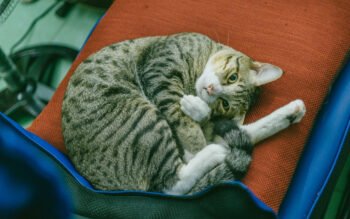From dealing with bad knees to recovering from a recent surgery, cats nationwide are benefiting from new interest in animal pain management treatments. These veterinary practices specializing in pain alleviation are now available to help you and your cat, no matter the situation, whether you have an elderly cat or one suffering from a more chronic condition.
How the Process Starts
All veterinarians offer pain medications, but you might want a specialist in pain management. If so, and depending on where you live, you might wind up at places like the Animal Pain Management Center in Snyder, N.Y.; The Downing Center for Animal Pain Management in Windsor, Colo.; or at Mountain Ridge Animal Hospital & Pain Management Center in Lafayette, Colo.
Even if you are seeking a second opinion, your cat will likely have to undergo routine blood work and X-rays. “These allow us to see exactly what’s going on,” says Michele Beveridge, practice manager of Mountain Ridge. Cats are notorious for hiding pain and illness. Conversely, some of their behaviors might be misinterpreted as pain. It’s therefore essential to find out the truth behind the symptoms. “We cannot just pass out medications,” says Beveridge. “If medications are prescribed, we also have to run routine blood tests, since each individual handles medications differently.”
Available Treatments
Once a diagnosis is made, one or more pain medications may be prescribed. Alternative treatments are also possible. These could be offered in addition to the prescribed meds. They may include one or more of the following:
- Acupuncture Small-animal acupuncture care is becoming more common both nationally and internationally. Mark Bianchi, a holistic veterinarian at the White Oaks Veterinary Clinic in Edmond, Okla., is certified to provide veterinarian acupuncture by the International Veterinary Acupuncture Society. “As pets age, natural wear and tear on the joins can lead to pain and reduce a pet’s ability to move comfortably,” says Bianchi. “Pets that have sustained an accident injury may also suffer recurring pain, even after the injury has healed. Pet acupuncture is a natural way to relieve this pain by restoring balance to the nervous system and enhancing a pet’s natural endorphins for pain relief.”
- Laser Therapy Laser therapy involves a low-light laser that is run over areas of the cat’s body. Doctors now use this kind of therapy on humans too. “It can decrease inflammation, improve blood flow to target areas and may decrease pain,” says Beveridge.
- Stem Cell Therapy To treat pain and chronic conditions, some veterinarians now also use another carryover from human medicine: stem cell therapy. “It requires a surgical procedure,” says Beveridge. “Fat is removed from the animal’s stomach. Stem cells are harvested from the fat and are then later injected into trouble sites.” Rob Landry, veterinarian and owner of Mountain Ridge, says she has successfully treated both dogs and cats with stem cell therapy.
Cats Can Live a Pain-free Life
Thanks to new therapies and animal pain management specialists, your cat has a very good chance of living a long, healthy and pain-free life. If your cat suffers from a serious illness, sometimes discomfort can hurt the chances for healing. For example, many cat cancer patients suffer from appetite loss after chemotherapy. Bianchi believes acupuncture can help to both relieve pain following cancer treatments and prevent this loss of appetite that often happens. Your cat then has a better chance of eating as usual, keeping your pet’s strength up at a time when fortitude is needed.
Your cat’s behavior might even improve for the better. “Many times, a pet may act out or be aggressive toward other humans or animals because of pain,” says Bianchi. “By relieving the pain, a pet’s natural even temperament emerges, resolving the behavioral problems.”






